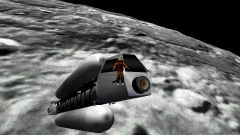Shuttle-D
| Shuttle-D | |
|---|---|

| |
| Shuttle-D in Low Lunar orbit | |
| Description | |
| Role | NTR Transport |
| Full name | Shuttle-D |
| Crew | 2 |
| Passengers | N/A |
| First flight | N/A |
| Entered service | N/A |
| Manufacturer | N/A |
| Dimensions | |
| Length | 62.90 m |
| Height | 10.61 m |
| Wingspan | 4.40 m |
| Wing area | N/A |
| Masses | |
| Empty | 14,770 kg |
| Fuel | 11,000 kg Liquid Hydrogen |
| RCS fuel | 2440 kg Hydrogen Peroxide |
| Max. take-off | 79,000 kg |
| Inertia PMI | 14.00 / 16.00 / 2.20 |
| Performance | |
| Max. delta-v | 4,253 m/s |
| Max. accel | N/A |
| Stall CL | N/A |
| Stall AOA | N/A |
The Shuttle-D is a NTR Spacecraft created by BruceJohnJennerLawso for the Orbiter space flight simulator. It is designed as a low to medium thrust, high ISP cargo transport and propulsion stage for missions to lunar space and beyond.
Features and capabilities[edit]
The Shuttle-D was designed as a cargo transport, inspired by the Shuttle-A included with the standard Orbiter package.
Launched onto a suborbital trajectory by a Delta IV Heavy launch vehicle, the Shuttle-D uses its NTR engine to provide the final velocity boost to Low Earth Orbit.
The original Shuttle-D was also designed as a cargo transport, able to carry a maximum of 50,000 kg of UCGO cargo in 18 slots. Actual payload to orbit may depend on the launch vehicle used and its abilities, with 10,000 kg being a realistic target with the Themis-A launch vehicle. UMMU support is also included, being able to carry 2 crew members with an oxygen supply for roughly 2 years 3 months. Crewmembers EVA'ed through the main dock can also activate the payload bays and the airlock via UMMU action areas.
The Shuttle-D can be flown via the Glass Window view or the Virtual Cockpit, which features a pair of functional MFD's. Vessel status can be monitored via various information displays on the HUD and the payload bays gear are controllable from there as well. Future versions may also include 2d panel displays and more displays in the Virtual Cockpit.
The RCS thrusters use Hydrogen Peroxide mono propellant fuel for attitude control and course corrections. The relatively low ISP (1.6 kN·s/kg in Vacuum) makes efficient use of RCS fuel important throughout a mission.
History and evolution[edit]
The Shuttle-D was originally inspired by the Shuttle-A cargo transport included with the standard Orbiter installation. Although originally designed with capabilities similar to the Shuttle-A, the design concept evolved in its later stages towards a more realistic design, based off of current or near term technology. The engine design was based off of the Russian RD-0410 Soviet NTR design, allowing for a high ISP, medium-to-low thrust engine in a much smaller package than the American NERVA.
The Shuttle-DB variant of was created for the 1.1 release, a redesign of the original DA version with an additional fuel tank in place of the cargo bay and an alternate RCS configuration for use while docked with other vessels. The DB version was intended for use as a tug for modules on orbit.
External links[edit]
- Shuttle-D 1.1 2012-12-16 at Orbiter-forum/resources.